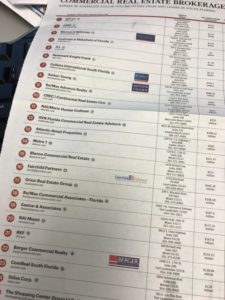Posted on August 10, 2017
The number of convenience-stores in the U.S. increased 0.2 percent to 154,535 from 2015 to 2016, accounting for more than $575 billion in sales, according to an Association for Convenience and Fuel Retailing (NACS) report. Roughly 80 percent of convenience stores also sell gasoline, which is helping to fuel rising in-store sales of a broad mix of merchandise for on-the-go shoppers.
Yet, today’s gas station/convenience store locations have a depth and breadth of product, image and branding not previously seen. They have curb appeal, and they aim to offer consumers a one-stop retail experience. While they don’t require as much square footage as typical grocery stores, they do need more space than the typical convenience stores of the past.
This phenomenon is evidenced by the exponential growth of chains like Wawa in Florida and the Southeast and 7-Eleven on the national level. These gas station/c-store properties will remain viable in today’s online, on-demand retail environment, due, in part, to their ability to maintain “convenience” as a key tenant of retail sales.
The professionals with Orion Real Estate Group work with investors, developers, property owners and brokers through all phases of real estate transactions, from strategic planning and analysis to financing, negotiation, property management and disposition. For more information, call (305) 278-8400 or email info@orionmiami.com.
or email info@orionmiami.com.
Posted on August 03, 2017
We are proud to be included in South Florida Business Journal’s annual list of the largest commercial real estate brokerages in South Florida. Our No. 17 ranking represents a lot of work on behalf of clients who want to maximize real estate investment opportunities.


Posted on August 02, 2017
Earlier this year, market research firm IBISWorld reported that the U.S. chain-restaurant market, which has been growing at a steady rate since 2012, is today an approximate $112.3 billion industry. Additionally, a report from business consultancy McKinsey and Company foresees restaurants driving the future of shopping malls, where leasable space devoted to food and beverage services is expected to increase from 10 percent to 25 percent by 2020 in response to consumers’ demands for improved shopping experiences.
This market shift presents investors with unique opportunities to diversify their real estate portfolios and capitalize on the growing market of net-leased restaurant properties, especially when considering a tax-deferred 1031 like-kind exchange. The price point and equity requirements of a quick-serve restaurant (QSR) with a long-term lease in place is typically right on target for the average individual investor, as are these properties’ cap rates.
Engaging in a tax-friendly 1031 exchange however does not come without challenges. In addition to navigating a complex technical landscape for effecting a 1031 exchange, property sellers and buyers must have an understanding of the commercial real estate market, both on the national and local levels, as well as the potential risks and rewards of different types of restaurants, including QSRs and sit-down establishments. Experienced real-estate professionals are an ideal source for gathering this detailed data and helping to guide investors through the process for maximizing the value for the investments over the long term.
The professionals with Orion Real Estate Group work with investors, developers, property owners and brokers through all phases of real estate transactions, from strategic planning and analysis to financing, negotiation, property management and disposition. For more information, call (305) 278-8400 or email info@orionmiami.com.
Posted on July 27, 2017
This real estate mantra, which has survived the historic highs and lows of the market, remains true to this day. The challenge for many property owners, however, is in knowing what location best meets their time and financial investment needs.
The priorities of a property buyer or seller determine the parameters of a great location. For example, scenic views and good school systems will often drive the decisions of residential property buyers. It is different for commercial real estate purchases, for which buyers must compile thorough market research and consult with knowledgeable professionals before committing to an investment-property location.
Today, urban areas in both Florida and Texas are attracting the attention of commercial real estate investors. This is due, in large part, to the fact that both states are among the mere seven in the nation in which taxpayers pay no personal income tax. As a result, these states are historically better able to create jobs, attract workers and drive business growth. Even with this, markets do tend to ebb and flow. Currently, the most popular markets for real estate investment in Florida are in Miami, Tampa, Jacksonville, Orlando and the Panhandle. In Texas, the North Dallas area, which includes Frisco and Plano, is experiencing a commercial real estate investment boon, and Austin remains among the top cities to own investment properties.
Experienced and astute real estate investment professionals are well-versed in the markets in which their clients own properties and they maintain a keen eye on the next burgeoning markets around the country. This perspective can be an invaluable resource to property sellers, buyers and potential investors.
The professionals with Orion Real Estate Group work with investors, developers, property owners and brokers through all phases of real estate transactions, from strategic planning and analysis to financing, negotiation, property management and disposition. For more information, call (305) 278-8400 or email info@orionmiami.com.
or email info@orionmiami.com.

